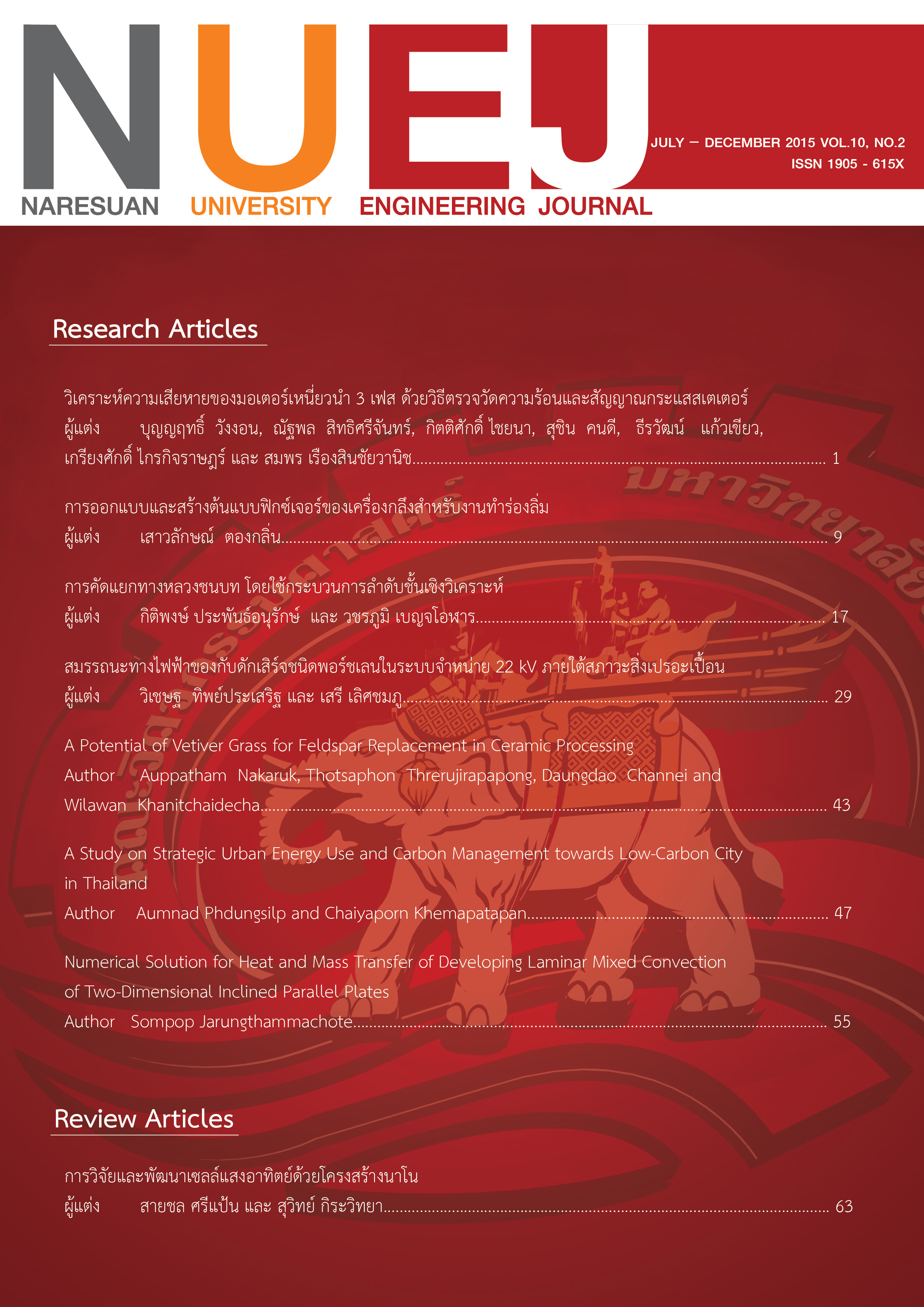Numerical Solution for Heat and Mass Transfer of Developing Laminar Mixed Convection of Two-Dimensional Inclined Parallel Plates
Main Article Content
Abstract
Two-dimensional, developing laminar mixed convection of a binary non-reacting gas mixture flowing in an inclined channel is investigated. A steady state condition is focused through the present study. Thermal boundary conditions of the channel are that one is uniform wall heat flux while the other is uniform wall temperature. Moreover, the walls of channel have different constant species concentrations. The numerical method, called implicit finite difference method, is applied to find hydraulic and heat transfer parameters, consisting of axial and transverse velocities, temperature, and mass fraction. The developments of these parameter profiles, presented in terms of dimensionless form, are observed and discussed. The analytical solution is also presented for fully developed region. The results show that thermal and solutal buoyancy parameters strongly affect on the axial velocity profile. The flow reversal is found near the constant temperature wall for some conditions. If the inclination angle increases, the flow reversal can clearly be observed nearer the inlet of channel. The dimensionless mass fraction, expressing the concentration of focused gas species, and the dimensionless temperature, reflecting the temperature of mixture in the channel, are also interested in this study. The dimensionless mass fraction and the dimensionless temperature profiles continuously change to be linear as distance along the flow direction increase. Based on the condition in this study, the dimensionless mass fraction profile can reach the fully developed condition faster than the dimensionless axial velocity and the dimensionless temperature profiles.
Article Details
References
W. Aung and G. Worku, “Theory of fully developed, combined convection including flow reversal,” J. Heat Transfer, vol. 108, pp.485-488, 1986.
A. Barletta and E. Zanchini, “On the choice of the reference temperature for fully-developed mixed convection in a vertical channel,” Int. J Heat Mass Transfer, vol. 42, pp. 3169-3181, 1999.
W.M Yan, “Effects of film vaporization on turbulent mixed convection heat and mass transfer in a vertical channel,” Int. J. Heat Mass Transfer, vol. 38, pp. 713-722, 1995.
K.T. Lee, H.L. Tsai, and W.M. Yan, “Mixed convection heat and mass transfer in vertical rectangular ducts,” Int. J. Heat Mass Transfer, vol. 40, pp.1621-1631, 1997.
A. Belhadj Mohamed, J. Orfi, A. Debbissi, and S. Ben Nasrallah, “Heat and mass transfer during condensation in a vertical channel under mixed convection,” Heat Mass Transfer, vol. 43, pp. 851-861, 2007.
M.M. Salah El-Din, ”Effect of thermal and mass buoyancy forces on the development of laminar mixed convection between vertical parallel plates with uniform wall heat and mass fluxes,” Int. J. Therm Sci., vol. 42, pp. 447-453, 2003.
K. Boulama and N. Galanis, “Analytical solution for fully developed mixed convection between parallel vertical plates with heat and mass transfer,” J. Heat Transfer-Trans ASME, vol. 126, pp. 381-388, 2004.
K. Boulama, N. Galanis, and J. Orfi, “Thermosolutal mixed convection and flow-reversal in an inclined parallel-plate channel,” Heat Mass Tranfer, vol. 48, pp. 1601-1613, 2012.
N. Laaroussi, G. Lauriat, and G. Desrayaud, “Effects of variable density for film evaporation on laminar mixed convection in a vertical channel,” Int. J. Heat Mass Transfer, vol. 52, pp. 151-164, 2009.
O. Oulaid, B. Benhammou, and N. Galanis, “Flow reversal in combined laminar mixed convection heat and mass transfer with phase change in a vertical channel,” Int. J. Heat Fluid Flow, vol. 31, pp. 711-721, 2010.
P.H. Oosthuizen and D. Naylor, An introduction to convective heat transfer analysis, McGraw-Hill; 1999.
T. Grosan, R. Pop, and I. Pop, “Thermophoretic deposition of particles in fully developed mixed convection flow in a parallel-plate vertical channel,” Heat Mass Transfer , vol. 45, pp. 503-509, 2009.


